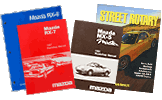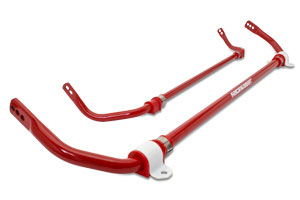
Powering Your Way Through The Corners - Upgrading The Sway Bars On Your Miata
Select the correct sway bar for your Miata:
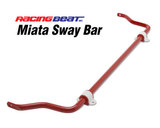
Sway Bar - Solid - Front
90-93 Miata
Racing Beat-designed sway bars for the 1990-93 Miata reduce chassis roll in turns and increase your car's ... ![]()
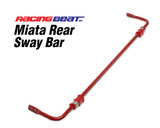
Sway Bar - Solid - Rear
90-00 Miata
Racing Beat Sway Bars - Production

Sway Bar - Solid - Front
94-97 Miata
Racing Beat-designed sway bars for the 1994-97 Miata reduce chassis roll in turns and increase your car's ... ![]()
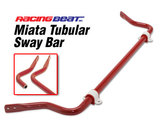
Sway Bar - Tubular - Front
99-00 Miata
Racing Beat-designed front tubular sway bar for the 1999-2000 Miata reduce chassis roll in turns and increase your ... ![]()
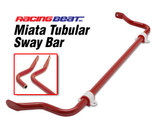
Sway Bar - Tubular - Front
90-93 Miata
Racing Beat's front tubular sway bars for the 1990-97 Miata applications offer you the ability to further tune ... ![]()

Sway Bar - Tubular - Front
94-97 Miata
Racing Beat's front tubular sway bars for the 1990-97 Miata applications offer you the ability to further tune ... ![]()
How can a set of sway bars change the handling of my Miata?
Sway bars have two functions: First, they reduce body roll when turning. Sway bars function without simply raising the "two wheel" spring rate - that is, they do increase the wheel rate for a "one wheel" bump such as a pothole, but they do not change the "two wheel" rate for things like pavement joints. Although this may not sound like a big deal, in practice, trying to restrict chassis roll with spring rates causes harsher ride characteristics than the same roll restriction with sway bars. There are a variety of reasons to restrict body roll. For one, the steering response to a turning input on the steering wheel is much crisper and clearer if the body doesn't have to roll at the start of the turn. For another, the angles with the pavement that develop as the wheels move up and down are often not ideal. By restricting these angles, more cornering power is usually available.
The second value of sway bars is that, by adjusting the stiffness of the front bar versus the rear, it is possible to change the understeer/oversteer/neutral steer characteristics of a car, making it easier to control and generally increasing cornering performance.

How does the addition of aftermarket sway bars impact the ride quality of my Miata?
Upgrading to larger diameter sway bars on your Miata will increase the general stiffness of the ride - but not by much. For most drivers, the improvement in steering crispness more than compensates for the minor increase in stiffness. Adding a set of performance springs and/or shocks will have a much greater impact on ride quality stiffness.
Can I just change either the front or rear bar on my Miata, why both?
You can change only the front or rear bars, but depending on where the car's handling balance was at the beginning, you will probably upset that balance. Nearly all of Mazda's cars have light to moderate understeer as delivered, largely to avoid oversteer (which is the tendency for the rear to slide sooner that the front), a condition that many people are not experienced enough with to deal with safely. Racing Beat typically designs and tests all of our Miata sway bars as pairs and recommends that they be used together as a matched-set.
How does Racing Beat select the bar diameters?
Partly based on experience, partly based on the performance of the original vehicle, and partly based on testing. Not only are we selecting the bar diameter, but in the case of a tubular sway bar application we are also comparing and selecting the specific wall thickness.
Is tubular better than "solid"?
Functionally, there is no practical difference between a tubular and a solid bar of equal torsional stiffness except that the solid bar will weigh more. The tubular bar will typically be larger in diameter, which may cause some clearance and space problems; it can't be bent as sharply as a solid bar; and the material may cost more.
How will my car perform after the installation of a set of sway bars?
You will immediately notice that the car is more responsive to steering inputs; the car will not roll as much in turns; and the ultimate cornering power and speed will increase. You'll find that you are able to carry more speed through the corner, which improves straight line acceleration and speed upon exiting the corner.
Does Racing Beat recommend upgraded sway bar endlinks for front and rear with aftermarket Miata sway bars?
It is not required but adding a set of upgraded sway bar endlinks (the component that connects the sway bar to the lower control arm) along with the stiffer aftermarket bars is strongly suggested. The added loads placed on the original OE endlinks may accelerate wear on the end ball-joint, causing the link to eventually fatigue and fail. Racing Beat Heavy Duty Endlinks feature adjustable ends to avoid pre-loading the bar and durable urethane bushings that provide excellent steering feedback and comfort.

Racing Beat offers several different Miata sway bars, which bars are correct for my application?
We offer sway bars for both street and track use. If you are just getting started with your sway bar upgrades we recommend you review our Miata Sway Bar Application Guide to determine the optimal bar set to meet your requirements.
Are sway bars difficult to install? Can I install them myself?
Miata sway bars are relatively easy to install, particularly the rear bar. If you own a floor jack, jack stands, a set of metric wrenches/socket tools, then you are well on your way to installing a set of sway bars. Racing Beat provides installation instructions, replacement bushings (and clamps if required), Prothane bushing grease, and any other required mounting hardware. Need more assistance? Simply give us a call if you have any other installation questions.
Selecting and Comparing Replacement Sway Bars
We often receive questions from our customers with inquires as how particular Racing Beat Sway bar might compare to another aftermarket bar - or even to another Racing Beat sway bar.
Due to the complexities involving sway bar tubing materials, wall thicknesses, arm lengths, endlink hole positions, etc... it can be extremely difficult for the end user to choose or compare different aftermarket sway bars. For one reason, there is no "standard" test method - no two manufacturers will utilize the exact same test methods to collect and translate their data. For another, it is difficult to convert any numerical rating to an actual in-car effect.
There are many ways of "rating" sway bars. The simplest (and the one Racing Beat uses) is to compare the torsional stiffness of the bar or tube size. (One quick note - all steel bars, whether 1018 mild steel or 4130 aircraft alloy, have the same torsional stiffness - that is, resistance to twisting.)
We do this by measuring the diameter of a solid bar and raising that number to the 4th power - that is, for a .875" OD diameter bar (.875 x .875 x .875 x .875) - which is about .59. This number, the diameter to the 4th power, becomes a "rating" of the bar's stiffness. This is based on the engineering formula for torsional stiffness of a circular bar.
For tubular bars, make the same calculation twice, once for the outside diameter and once for the inside diameter, then subtract the smaller number from the larger to get the bar's rating. For example, compare the previously rated bar (.875" OD diameter) to a tubular bar with a stated 1.125" outside diameter and .75" inside diameter. First calculate the rating for the outside diameter (1.125 x 1.125 x 1.125 x 1.125 = 1.60), next calculate the rating for the inside diameter (75 x .75 x .75 x.75 = 1.60), then subtract the outer rating from the inner rating (1.6 - .32) for a tubular bar rating of 1.28. Comparing this 1.125" OD tubular to the .875" OD solid bar, 1.28 divided by .59 means that the tubular bar is about 2.17 times as stiff as the solid bar.
Now come the cautions: This method does NOT account for the effect of bending in the arms; for differences in shape between various bars; and most important, the differences in bushings and clamps. The good news is that, based on all of our experience, it is still a very good guide. It is especially good when comparing two bars with a similar design and comparable bushings. For example, if you have one set of bars installed, your car is balanced, and you want to change the roll stiffness, just select a new bar for one end of the car, see the change in rating, then find a new bar for the other end of the car that has the approximate same rating change - and the car will retain the same balance it had previously.
Over time, Racing Beat has found that the clamps and bushings that support the bar have a large and important effect on the performance of the bar. Rubber bushings (which Mazda uses) are quiet, durable and require no lubrication. Unfortunately, they also dampen the characteristics of a bar so much that they should not be used in performance applications. When the suspension applies a load to the sway bar, some of the motion is absorbed by the twisting and bending of the bar but some is absorbed by the bushings. The softer the bushings the lower the effective stiffness of the bar. In general, rubber is much softer and more compliant than the urethane bushings used by Racing Beat. Keep these considerations in mind when attempting to compare specifications of various aftermarket sway bars - the specific bushings used may have a significant impact on your bar rating expectations and cannot easily be factored into most comparisons.
We are often asked if there are there standard percentage increases in effective bar stiffness if the endlink mounting position is moved either inward or outward from the recommended center hole position of a sway bar.
The effect of moving the attachment point of a sway bar link on a sway bar depends on the radial distance from the centerline of the bar bushings to the original attachment point and the amount and direction of the movement. Shortening this radial distance makes the bar stronger while lengthening it weakens the bar.
The amount of change is obtained by dividing the original radial distance in inches by the new radial distance in inches. Convert this result to "percent" by multiplying it by 100 (e.g., 8"/7" = 1.14, multiply by 100 = 114 percent). Thus, shortening the arm from 8" to 7" increases the roll stiffness 14% (above 100 percent). This procedure is not exact, but it is a good approximation for the small changes usually available in arm length.
